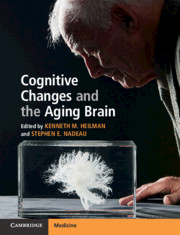Book contents
- Cognitive Changes and the Aging Brain
- Cognitive Changes and the Aging Brain
- Copyright page
- Dedication
- Contents
- Contributors
- Chapter 1 Introduction
- Chapter 2 Anatomic and Histological Changes of the Aging Brain
- Chapter 3 Cellular and Molecular Mechanisms for Age-Related Cognitive Decline
- Chapter 4 Neuroimaging of the Aging Brain
- Chapter 5 Changes in Visuospatial, Visuoperceptual, and Navigational Ability in Aging
- Chapter 6 Chemosensory Function during Neurologically Healthy Aging
- Chapter 7 Memory Changes in the Aging Brain
- Chapter 8 Aging-Related Alterations in Language
- Chapter 9 Changes in Emotions and Mood with Aging
- Chapter 10 Aging and Attention
- Chapter 11 Changes in Motor Programming with Aging
- Chapter 12 Alterations in Executive Functions with Aging
- Chapter 13 Brain Aging and Creativity
- Chapter 14 Attractor Network Dynamics, Transmitters, and Memory and Cognitive Changes in Aging
- Chapter 15 Mechanisms of Aging-Related Cognitive Decline
- Chapter 16 The Influence of Physical Exercise on Cognitive Aging
- Chapter 17 Pharmacological Cosmetic Neurology
- Chapter 18 Cognitive Rehabilitation in Healthy Aging
- Chapter 19 Preventing Cognitive Decline and Dementia
- Index
- References
Chapter 6 - Chemosensory Function during Neurologically Healthy Aging
Published online by Cambridge University Press: 30 November 2019
- Cognitive Changes and the Aging Brain
- Cognitive Changes and the Aging Brain
- Copyright page
- Dedication
- Contents
- Contributors
- Chapter 1 Introduction
- Chapter 2 Anatomic and Histological Changes of the Aging Brain
- Chapter 3 Cellular and Molecular Mechanisms for Age-Related Cognitive Decline
- Chapter 4 Neuroimaging of the Aging Brain
- Chapter 5 Changes in Visuospatial, Visuoperceptual, and Navigational Ability in Aging
- Chapter 6 Chemosensory Function during Neurologically Healthy Aging
- Chapter 7 Memory Changes in the Aging Brain
- Chapter 8 Aging-Related Alterations in Language
- Chapter 9 Changes in Emotions and Mood with Aging
- Chapter 10 Aging and Attention
- Chapter 11 Changes in Motor Programming with Aging
- Chapter 12 Alterations in Executive Functions with Aging
- Chapter 13 Brain Aging and Creativity
- Chapter 14 Attractor Network Dynamics, Transmitters, and Memory and Cognitive Changes in Aging
- Chapter 15 Mechanisms of Aging-Related Cognitive Decline
- Chapter 16 The Influence of Physical Exercise on Cognitive Aging
- Chapter 17 Pharmacological Cosmetic Neurology
- Chapter 18 Cognitive Rehabilitation in Healthy Aging
- Chapter 19 Preventing Cognitive Decline and Dementia
- Index
- References
Summary
The anatomic networks and physiological processes that mediate taste, oral somatosensation, and smell undergo age-related decline. This chapter reviews results of psychophysical studies that have sought to understand the mechanisms responsible for the decline in the gustatory, somatosensory, and olfactory systems. There appears to be a slowing of cell regeneration, atrophy, and loss of connectivity of the primary central nervous system structures critical for these functions. Older adults have elevated detection thresholds, whereas supra-threshold intensity measurements, depending on tastant and odorant concentrations, may show only modest or no change. Identification is often the most impaired function. With aging, variation of function is much higher. In good part, this reflects variable damage to taste and olfactory structures in the mouth and nasopharynx caused by environmental insults. Overall, it appears that aging affects olfaction more than taste. While decrements in taste may influence food preferences and dietary intake, as well as reduce quality of life in the realm of food enjoyment and nutritional intake, these changes are largely related to the ability to perceive flavor, which is most dependent on retronasal olfaction, reflecting the combined central nervous system processing of inputs from nasopharyngeal olfactory sensors and taste and oral somatosensors.
- Type
- Chapter
- Information
- Cognitive Changes and the Aging Brain , pp. 68 - 94Publisher: Cambridge University PressPrint publication year: 2019
References
- 1
- Cited by



